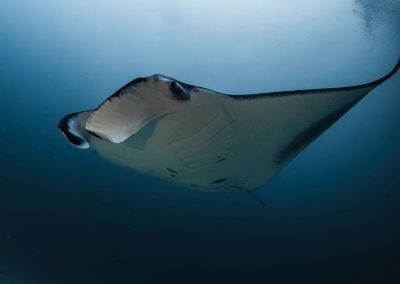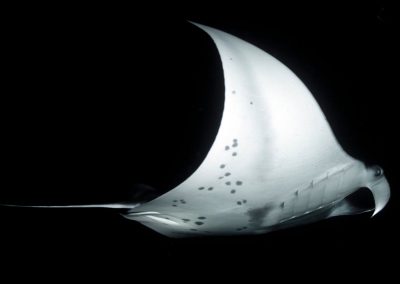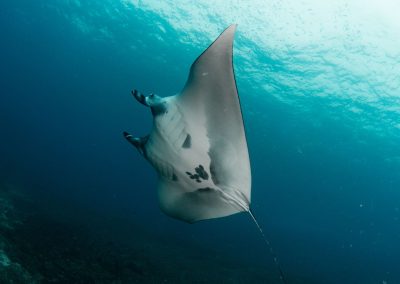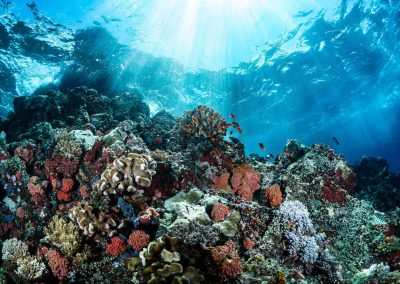For decades, we believed there was only one type of manta ray in our oceans. But in 2009, researchers discovered there were actually two distinct species: reef mantas (Mobula alfredi) and pelagic or oceanic manta rays (Mobula birostris), also called “giant” mantas. In July 2025, we got official confirmation of what marine biologists suspected for years: a third species exists in the Atlantic waters.
This newly identified species was formally described in Environmental Biology of Fishes in July 2025, as “mobula yarae”; it’s named after Yara, a water spirit from Indigenous Brazilian mythology. Before it was officially recognised, the species was referred to as the “Caribbean manta ray” and some still do. The name “Atlantic manta ray” better reflects where the Mobula yarae can be found: across the western Atlantic Ocean, not just Caribbean waters.
This manta represents one of the most significant marine species discoveries in recent decades, and it has marine biologists excited about what other discoveries might lurk beneath the waves.
The Discovery Journey
The story of the Atlantic manta begins with Dr. Andrea Marshall. In 2009, she demonstrated that what we always thought of as “the manta ray” was actually two distinct species: the reef manta and the oceanic/pelagic manta. According to Hakai Magazine, during her research, Marshall predicted a third species might even exist – but these rays proved difficult to study closely.
Then, around 2010, Marshall encountered what she immediately recognized as something different while diving off the Yucatán in Mexico. As she later reflected: “It had taken me six years to differentiate the first two species, and I knew them inside out at this stage. This manta didn’t look like either of them.”
This was the beginning of a new journey: for over a decade, researchers worked to gather the evidence needed for a formal scientific description. Over the years, divers and photographers unknowingly captured images of Mobula yarae, which were extremely valuable at this stage.
The pivotal moment came in July 2017, when the Marine Megafauna Foundation identified a dead manta ray off Pompano Beach, Florida, as the “type specimen” for this third species. Genetic testing confirmed that this individual was different; this allowed researchers to draft a formal definition of the species.
While the 2017 specimen was key, scientists faced the challenge of collecting enough genetic samples from live animals across different regions to confirm that this wasn’t just a one-off mutation.
In 2021, a collaborative study by Josh Stewart of the Manta Trust and Emily Humble from the University of Edinburgh provided the strongest genetic evidence yet. Unlike reef mantas that return to predictable sites, these Atlantic mantas roam vast, open waters, making them hard to find. Stewart and co gathered tissue samples from nurseries in the Gulf of Mexico and even fish markets, building a more comprehensive genetic profile that left little doubt: this was a distinct species.
Stewart described the significance of this finding: “The fact that we are still identifying new species of megafauna is amazing. These aren’t tiny gobies that can go around undetected.”
Unfortunately, the person who kickstarted the search for a third manta species, Dr. Andrea Marshall, suffered a severe brain aneurysm and stroke in early 2024, preventing her from completing the formal description herself. Her incredible work was finished by an international research team led by Brazilian researcher Nayara Bucair from the University of São Paulo, wrapping up Marshall’s pioneering research in 2025.
How to Identify an Atlantic Manta Ray
Mobula yarae shares characteristics with both existing manta species, which explains why it was unrecognized for so long. The newly described species displays what researchers call “a mix of traits”: from above, it looks like a giant oceanic manta, while from below, it resembles a reef manta.
As described in this article by the Manta Trust, key distinguishing features include:
- V-shaped white shoulder markings forming two mirror-image right-angled triangles. Unlike the oceanic manta’s T-shaped marking that maintains an even width, the Atlantic manta’s marking tapers together where it joins the back.
- Ventral markings (the markings on the underside of the manta) are clustered around the lower abdominal region; they do not extend between the gills like in reef manta rays
- They often have large patches of round or oblong shaded areas on the ventral side below the gills
- Distinctive dermal denticles differ in shape from both oceanic and reef mantas
The Marine Megafauna Foundation added to this:
- Face coloration: Lighter coloration around the mouth and eyes compared to the darker faces of giant mantas
- Size: Can grow 5-6 meters (16-20 feet) like giant mantas, though many observed individuals are smaller juveniles
- Most of the observed individuals have been found in coastal waters, like reef mantas, despite their large size
The color patterns of Atlantic manta rays can vary wildly from one individual to the next. This made them challenging to identify for years, but consistent features have now been well-documented, which helps both scientists and ocean lovers tell them apart.
You’ll find close-up photos of the Atlantic manta ray on the Sharks and Rays website, and a side-by-side comparison of reef, oceanic, and Atlantic manta rays on the website of the Marine Megafauna Foundation.
Where Atlantic Mantas Live
Mobula yarae inhabits tropical and subtropical waters throughout the western Atlantic Ocean, from the eastern United States to Brazil, including the Gulf of Mexico and Caribbean Sea. They live in coastal reefs, unlike oceanic manta rays, which spend most of their time in the open ocean.
Scientists theorize that pioneering oceanic mantas may have crossed the open ocean to the Atlantic, found plentiful food sources along the inshore reefs, and gradually evolved into this new species – essentially replicating the evolutionary path that produced reef mantas elsewhere.
The best places to spot these creatures include the Mexican Caribbean, Florida waters, and coastal Brazil. They prefer coastal areas as well as oceanic islands.
Conservation Status and Concerns
Since it had only just been recognised at the time of this writing, Mobula yarae hadn’t yet received an independent assessment of its conservation status on the IUCN Red List. It’s currently grouped with the oceanic manta ray, which is listed as globally endangered on the IUCN Red List.
In Mexico, mantas receive some protection under NOM-059-SEMARNAT-2010 in the category of Special Protection. However, they face threats from fishing both for food and for their gill rakers, which are used in some traditional medicine practices.
The Atlantic manta’s coastal preference makes it more vulnerable to human impacts than oceanic species. Research has documented boat strikes and fishing line entanglement as significant threats in Florida waters, while shrimp trawling poses risks in the Gulf of Mexico.
As Jessica Pate of the Marine Megafauna Foundation explains: “You can’t protect what you haven’t formally identified. Now that we’ve proven that this Atlantic manta ray is distinct, we can tailor our research and conservation initiatives to protect the species.”
The mysteries that remain
The discovery of Mobula yarae offers scientists a rare glimpse into evolution in real time. Genetic evidence suggests that this species diverged relatively recently from other manta rays; this helps scientists understand how large marine species adapt and evolve.
The discovery shows how much we still have to learn about our oceans’ inhabitants. Despite their massive size and the fact that they’ve lived alongside humans in coastal communities for generations, an entire species of megafauna was scientifically unrecognized until recently.
Here at Manta Ray Advocates, the discovery of a potential third manta species reinforces what we’ve long known – that these gentle giants still hold many mysteries, and continued research is essential for both understanding and protecting them.














0 Comments